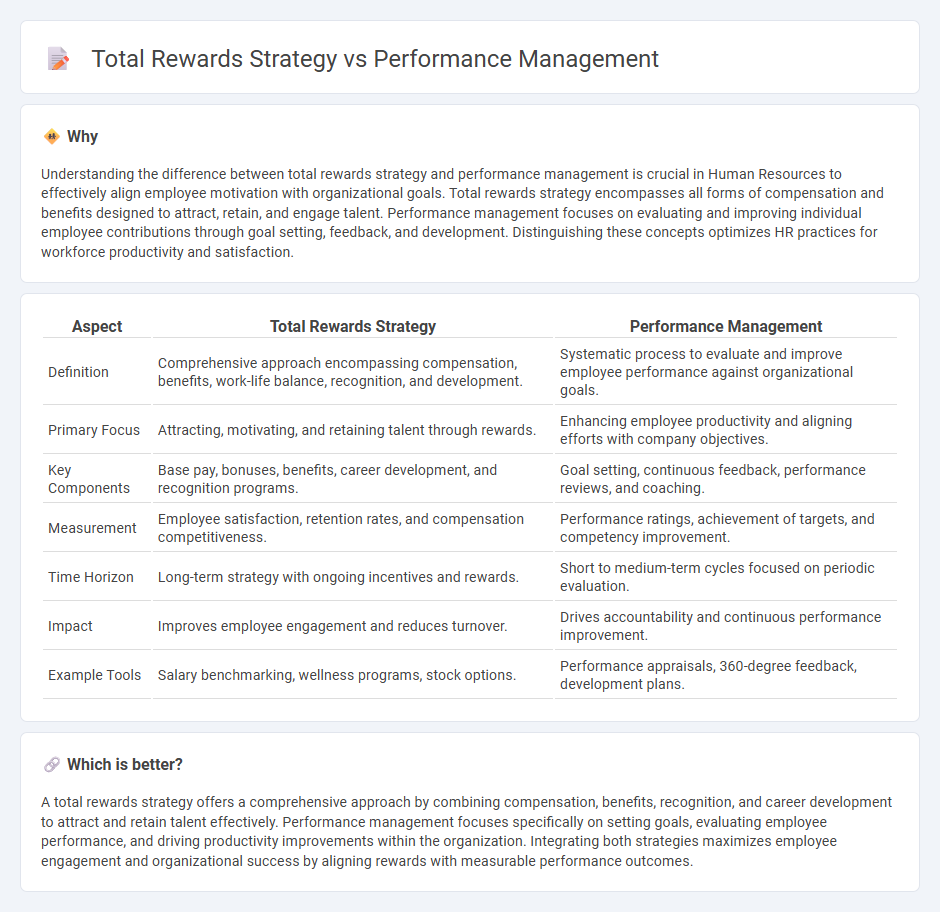
Total rewards strategy encompasses salary, benefits, incentives, and recognition programs designed to attract, motivate, and retain employees, focusing on holistic employee value proposition. Performance management targets continuous evaluation, feedback, and development to boost employee productivity and align individual goals with organizational objectives. Explore how integrating total rewards and performance management drives sustainable workforce engagement and business success.
Why it is important
Understanding the difference between total rewards strategy and performance management is crucial in Human Resources to effectively align employee motivation with organizational goals. Total rewards strategy encompasses all forms of compensation and benefits designed to attract, retain, and engage talent. Performance management focuses on evaluating and improving individual employee contributions through goal setting, feedback, and development. Distinguishing these concepts optimizes HR practices for workforce productivity and satisfaction.
Comparison Table
| Aspect | Total Rewards Strategy | Performance Management |
|---|---|---|
| Definition | Comprehensive approach encompassing compensation, benefits, work-life balance, recognition, and development. | Systematic process to evaluate and improve employee performance against organizational goals. |
| Primary Focus | Attracting, motivating, and retaining talent through rewards. | Enhancing employee productivity and aligning efforts with company objectives. |
| Key Components | Base pay, bonuses, benefits, career development, and recognition programs. | Goal setting, continuous feedback, performance reviews, and coaching. |
| Measurement | Employee satisfaction, retention rates, and compensation competitiveness. | Performance ratings, achievement of targets, and competency improvement. |
| Time Horizon | Long-term strategy with ongoing incentives and rewards. | Short to medium-term cycles focused on periodic evaluation. |
| Impact | Improves employee engagement and reduces turnover. | Drives accountability and continuous performance improvement. |
| Example Tools | Salary benchmarking, wellness programs, stock options. | Performance appraisals, 360-degree feedback, development plans. |
Which is better?
A total rewards strategy offers a comprehensive approach by combining compensation, benefits, recognition, and career development to attract and retain talent effectively. Performance management focuses specifically on setting goals, evaluating employee performance, and driving productivity improvements within the organization. Integrating both strategies maximizes employee engagement and organizational success by aligning rewards with measurable performance outcomes.
Connection
A well-designed total rewards strategy directly influences performance management by aligning employee incentives with organizational goals to enhance productivity and engagement. Performance management systems provide critical data and feedback that inform and refine total rewards, ensuring compensation, benefits, and recognition effectively motivate desired behaviors. Integrating these components creates a cohesive approach that drives talent retention, boosts morale, and maximizes overall organizational performance.
Key Terms
Performance Management:
Performance Management centers on setting clear individual goals, continuous feedback, and regular performance evaluations to drive employee productivity and align efforts with organizational objectives. It leverages tools like key performance indicators (KPIs), performance appraisals, and development plans to enhance skillsets and achieve measurable outcomes. Explore detailed strategies and benefits of Performance Management to optimize workforce effectiveness.
Goal Setting
Performance management emphasizes clear, measurable goal setting to enhance employee productivity and align individual objectives with organizational priorities. Total rewards strategy incorporates goal setting by linking performance outcomes to compensation, benefits, and recognition programs to motivate and retain talent. Explore how integrating goal setting within both frameworks drives business success and employee engagement.
Feedback
Performance management emphasizes continuous feedback to enhance employee skills, productivity, and alignment with organizational goals, fostering a culture of improvement and accountability. Total rewards strategy integrates feedback mechanisms to ensure compensation, benefits, and recognition resonate with employee contributions and preferences, boosting engagement and retention. Discover how aligning feedback within these frameworks drives organizational success and employee satisfaction.
Source and External Links
What Is Performance Management? The Complete Guide - AIHR - Provides an in-depth look at performance management, including its methods and benefits in enhancing employee performance and organizational success.
What is Performance Management and Why is it Important? - ADP - Explains the importance and process of performance management, including its role in motivating employees and increasing productivity.
What is Employee Performance Management? - Qualtrics - Discusses the balance between employee performance and business value, highlighting the use of technology in managing performance effectively.
 dowidth.com
dowidth.com